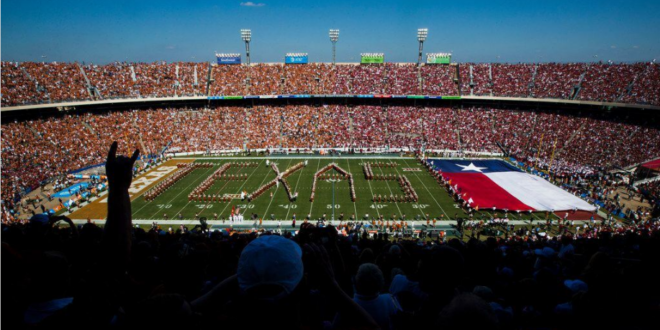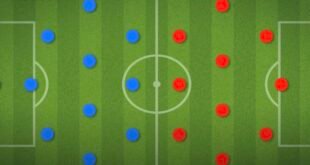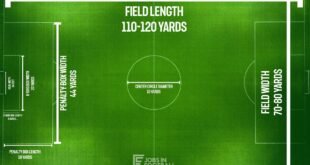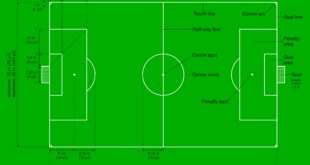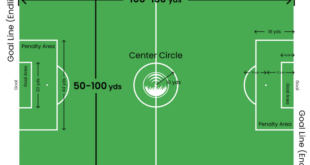A World Cup soccer field is approximately 110–120 yards long and 70–80 yards wide. The dimensions can vary slightly depending on the specific stadium hosting the matches.
World Cup fields are larger than high school soccer fields, which are typically around 100 yards long and 50 yards wide. FIFA sets specific guidelines for the dimensions of soccer fields, ensuring consistency and fairness throughout the tournament. The size of the field allows for fast-paced gameplay and strategic positioning of players.
These dimensions are crucial in determining the flow and dynamics of World Cup matches.
A World Cup soccer field
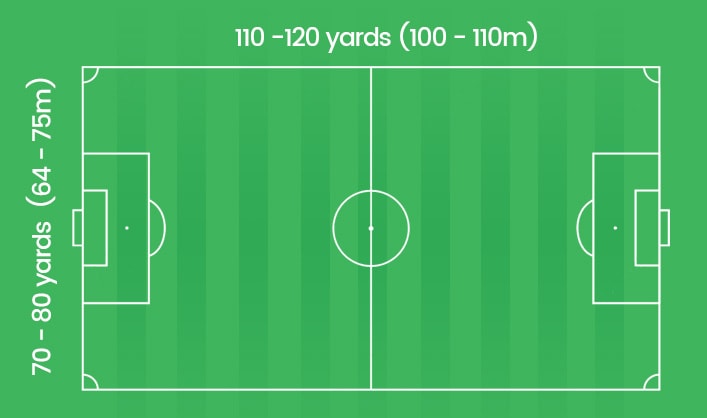
Table of Contents
Regulation Field Dimensions
In the world of soccer, the dimensions of a regulation field play a crucial role in determining the flow and strategy of the game. From the length to the width, every measurement has been carefully determined by FIFA (Fédération Internationale de Football Association) to ensure fair play and international standards. Let’s dive into the specifics of these regulation field dimensions:
Length
The length of a regulation soccer field, as defined by FIFA, is between 100 yards (91.44 meters) and 120 yards (109.7 meters). This distance stretches from one goal line to the other. To put it into perspective, that’s roughly the length of a football field. The specific length varies depending on the available space and the preferences of the hosting stadium.
Width
When it comes to the width of a regulation soccer field, FIFA sets a range between 50 yards (45.72 meters) and 100 yards (91.44 meters). This measurement is taken from one touchline to the next. This range allows for different variations in stadium sizes, ensuring that the game can be played on a suitable field regardless of the venue.
To provide a clear visual representation, here’s a table summarizing the regulation field dimensions:
| Field Dimension | Measurement |
|---|---|
| Length | 100-120 yards (91.44-109.7 meters) |
| Width | 50-100 yards (45.72-91.44 meters) |
As you can see, the regulation field dimensions provide a standardized framework for soccer matches at the highest level. These measurements allow players to adapt their tactics and strategies based on the size of the field, ensuring fair competition and exciting gameplay for spectators worldwide.
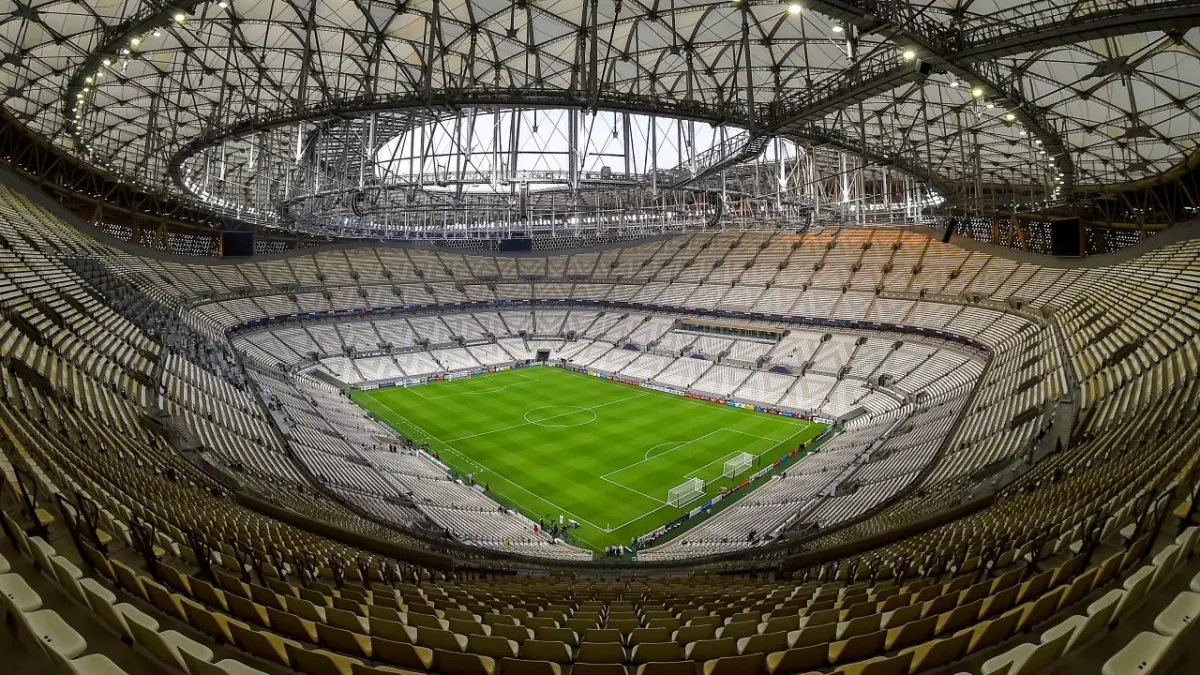
Field Markings
The size of a World Cup soccer field typically measures around 110–120 yards in length and 70–80 yards in width, meeting FIFA regulations. The field markings include a center circle, penalty area, and goal area. These dimensions ensure a standard playing surface for international matches.
The field markings on a soccer field play a crucial role in determining the dimensions and boundaries of the game. Let’s take a closer look at some of the key markings that you will find on a standard soccer field.
Center Circle
The center circle is an essential marking on a soccer field, located at the center of the pitch. It has a radius of 39.37 feet (12 meters) and is used to indicate where the game begins at the start of each half and after a goal is scored.
Penalty Area
The penalty area, also known as the 18-yard box, is a crucial area on the soccer field where fouls and penalties are awarded. It is located at each end of the pitch and measures 36.58 feet (11 meters) from the goal line. In summary, the field markings on a soccer field, including the center circle and penalty area, are essential for defining the dimensions and boundaries of the game. Understanding these markings is vital for players and spectators alike to follow the rules and enjoy the game to the fullest.
Goal Size
One of the key elements of a soccer field is the size of the goals, which determines the dimensions of the goal area. The goal size is essential for the game and plays a significant role in the scoring aspect. Understanding the dimensions and specifics of the goal size can provide a deeper insight into the game and elevate a spectator’s appreciation for the game’s dynamics and strategies.
Dimensions
The regulation size for a soccer goal is 8 feet in height and 24 feet in width. These dimensions have remained consistent for both professional and amateur levels of the game, adding a standard quality to the sport. The goalposts and crossbar, all of which are equal in width and depth, are typically made of wood, metal, or other approved materials that ensure their sturdiness and integrity during play.
Goal Area
The goal area, commonly known as the 6-yard box, is located at each end of the field and extends 6 yards (18 feet) from the goal line into the field. This area is essential for penalty kicks, protecting the goalkeeper, and regulating the opponent’s proximity to the goal during certain set plays. The 6-yard box provides a clear demarcation for specific game situations, ensuring fair and regulated gameplay.
Technical Area
In soccer, the Technical Area is a specified space on the sideline where the coaches and other team officials are allowed to stand and communicate with the players during the match. This area holds great significance in the world of soccer, as it allows the coaching staff to direct and guide the players during the live play. Let’s take a closer look at the key components of the Technical Area.
Coach’s Box
The Coach’s Box is a designated area within the Technical Area where the head coach or manager of the team can stand and give instructions to the players. It is typically marked by a rectangular box on the sideline, providing the coach with a clear and prominent position from which to oversee the match. The Coach’s Box is crucial for the effective management of the team’s performance on the field, enabling the coach to communicate strategic instructions and make tactical decisions in real time.
Substitution Zone
The Substitution Zone is an essential part of the Technical Area that allows teams to make player substitutions during the game. This area is located within the Technical Area and is marked by a designated zone where players can enter or exit the field as part of a substitution. The substitution zone is strategically positioned near the halfway line, providing a seamless and efficient process for teams to make tactical changes by replacing players during the match.
Additional Features
Additional Features of a World Cup Soccer Field
Corner Arcs
In a soccer field, the corner arcs are essential components that add strategic dimensions to the game.
Goal Line Technology
The introduction of goal-line technology has significantly impacted the game by providing accurate decisions on whether a goal has been scored.
Non-regulation Fields
While the official dimensions of a World Cup soccer field are standardized, there are also non-regulation fields used for various purposes. These fields cater to different styles of play and enable soccer enthusiasts to enjoy the game in a more specialized setting. Let’s explore two types of non-regulation fields: Small-sided Soccer Fields and Futsal Courts.
Small-sided Soccer Fields
Small-sided soccer fields, also known as mini-pitches, are smaller versions of traditional soccer fields. These fields provide a more compact playing area, creating a fast-paced and intense game environment. The dimensions of small-sided soccer fields can vary, but they typically range from 30 to 50 yards in length and 20 to 40 yards in width. These scaled-down fields are commonly used for recreational games, training sessions, and small tournament matches.
Futsal Courts
Futsal is a variant of soccer played on a hard court with a smaller, weighted ball. Futsal courts have specific dimensions set by FIFA to ensure a high-intensity, skill-focused game. The dimensions of a futsal court are usually 38 to 42 meters in length and 18 to 22 meters in width. Futsal courts feature lines and markings that help facilitate quick passes, fast-paced dribbling, and close ball control. This dynamic game is beloved for its emphasis on technique, creativity, and agility.
These non-regulation fields provide unique soccer experiences that cater to different preferences and playing styles. Whether you prefer the small-sided intensity of mini-pitches or the technical challenge of futsal, these alternative fields offer exciting opportunities to enjoy the beautiful game in a specialized setting.
Comparative Analysis
The size of a World Cup soccer field is larger compared to a standard soccer field. The official dimensions for a FIFA World Cup soccer field are approximately 110–120 yards in length and 70–80 yards in width.
Versus Other Sports Fields
In comparison to other sports fields, a World Cup soccer field stands out for its unique dimensions and specifications. While various sports, such as football, rugby, and American football, have their own field sizes and layouts, a World Cup soccer field showcases distinct lengths and widths that are specific to the game.
International Standards
When it comes to international standards, FIFA has established specific guidelines for the dimensions of a World Cup soccer field. The standard length ranges from 100 to 110 meters, and the standard width ranges from 64 to 75 meters. These precise measurements ensure that all World Cup matches are played on fields of uniform size, contributing to fair and consistent gameplay throughout the tournament.

Conclusion
World Cup soccer fields are vast, spanning about 100 by 70 meters. Understanding these dimensions enhances appreciation for the sport. Explore further to delve into the intricacies of soccer field measurements. Immerse yourself in the world of soccer!
 Cric Enjoy Sports News, Cricket Update, Live Streaming
Cric Enjoy Sports News, Cricket Update, Live Streaming
